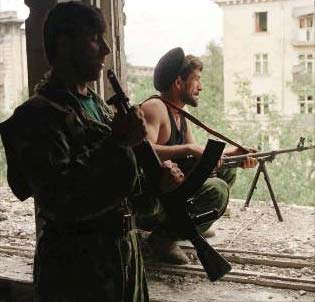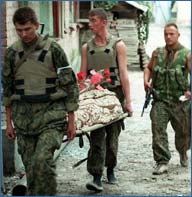On December 11, 1994, declaring the need to “disarm illegal armed formations,” President Yeltsin directed Russian troops to invade Chechnya. Aerial bombings and fierce fighting broke out across the breakaway republic.
Russian troops made slow progress in advancing on Grozny, held up by unarmed civilian protesters as well as by Chechen fighters and their own lack of supplies and seasoned soldiers. On January 19, 1995, after a cease-fire collapsed, Russian forces seized Dudayev’s presidential palace and flew the Russian flag. But despite this and other Russian strategic gains, the rebel attacks continued. Morale hit a new low in June, when rebel leader Shamil Basayev crossed into Russian territory and took 1,000 hostages at a hospital in Budyonnovsk. Months later, a copycat attack led by Salman Raduyev, a Dudayev relative, succeeded in surrounding the Russian-held Chechen town of Gudermes. As Russian forces maintained a six-day bombardment, the rebel fighters simply slipped away. Just weeks later, Raduyev would strike again in the Russian town of Kizlyar, this time taking 3,000 hostages.
Russia appeared to gain an upper hand in April 1996, when Russian forces, using a signal from Dudayev’s mobile phone, killed the Chechen president in a missile attack. At a joint press conference with U.S. President Bill Clinton, Yeltsin declared that “there are no military operations in Chechnya.” Events would soon prove him wrong.
Regaining control of Grozny in August, Chechen fighters forced Russian troops to talks and signature of a peace agreement on August 31, 1996. The settlement, which postponed consideration of Chechnya’s political status until 2001, was a de facto recognition of Chechen independence.
Did You Know?
An estimated 40,000 people – both military and civilians – died in Chechnya’s 1994-1996 war with Russia. More than 300,000 residents of Chechnya left the republic as refugees.
- Previous: 1990s: Independence
- Next: 1997 – War with Russia I...




